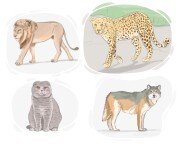ACT Science - Animal Life and Evolution
Here you will learn some English words related to animal life and evolution, such as "endemic", "diurnal", "toxicity", etc. that will help you ace your ACTs.
review
flashcard
spelling
quiz

(of plants or animals) feeding on the meat or flesh of other animals
(of an animal) solely feeding on plants
an organism that cannot produce its own food and must obtain energy by consuming other organisms or organic matter
an organism that breaks down and feeds on dead organic matter, such as decaying plant and animal material
relating to organisms that live on or inside other organisms, benefiting at the expense of their hosts
the process of waking up or becoming active and alert, often influenced by environmental stimuli or internal biological rhythms
(of some animals or plants) to spend the winter sleeping deeply
a toxic substance produced and secreted by certain animals, typically used for defense or hunting
the harmful effects or potential for harm caused by a substance to living organisms or the environment
the capacity or ability of an organism, often referring to its genetic potential, reproductive success, or influence within its environment
the place or area in which certain animals, birds, or plants naturally exist, lives, and grows
(of wild animals) hunting, killing, and feeding on other animals for survival
a community of living organisms together with their physical environment, interacting as a system
primarily active or occurring during the daytime
(of animals or organisms) primarily active during the night
(of an animal) active during the twilight hours of dawn and dusk
to bring up partially digested food from the stomach back into the mouth, often to feed young or as part of the digestive process
the internal bony structure of an animal that gives it form and supports its weight
the hard outer covering that supports the body of an animal, such as an arthropod
(of an animal, plant, etc.) not having any living members, either due to natural causes, environmental changes, or human activity
the process of bringing extinct species back to life through scientific methods
(of a wild animal) tamed and adapted to live with or to the benefit of humans
the protection of the natural environment and resources from wasteful human activities
the scientific process of creating an identical or near-identical copy of a living organism, cell, or DNA sequence through asexual reproduction or genetic engineering techniques
related to evolution or the slow and gradual development of something
a taxonomic rank below species that represents a distinct population within a species, exhibiting consistent differences from other populations
characteristic of an early stage of human or animal evolution
found or restricted to a specific geographic region or habitat
an extinct large, elephant-like mammal with long, curved tusks and a body covered in hair, which lived during the Pleistocene epoch
an extinct hominid species closely related to modern humans, characterized by a robust build and distinctive facial features, that lived in Europe and parts of Asia until approximately 40,000 years ago














